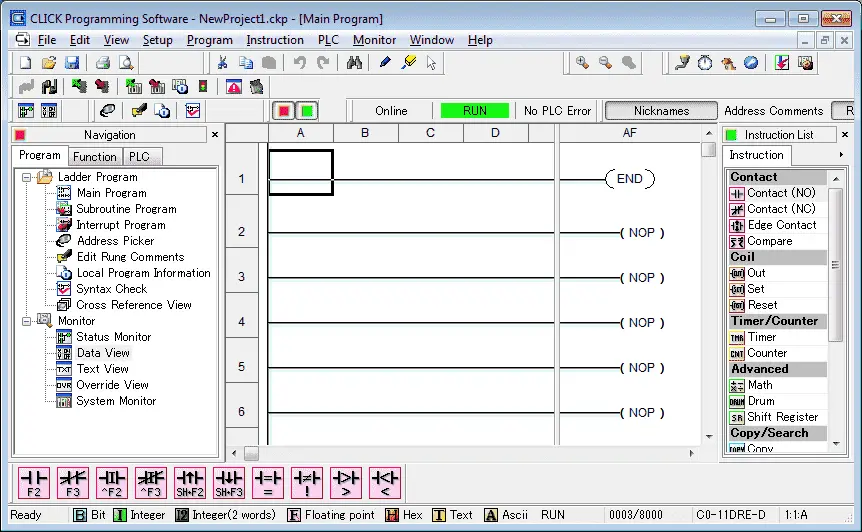Introduction
Understanding the Hardware is the first step of working with Programmable Logic Controllers (PLCs). In this tutorial, we will be going over the entire ControlLogix platform which is the flagship product from Rockwell Automation.
ControlLogix is classified as a large control system which is typically used in plant-wide applications. This platform allows PLC Programmers to have full control over various local and remote systems. ControlLogix hardware is critical in many facilities and provides a level of flexibility, unlike any other PLCs. Furthermore, it has the most memory and fastest speed available when compared to other systems from Allen Bradley.
This video is a demo on how to change a card in a Compactlogix PAC rack. Slots are numbered from left to right, starting at zero, on rack 1. I'm not 100% sure how the second rack is handled on SLC, as I've not set them up personally, but if it's the same as Compact Logix, the numbering just continues on - so if you have two 10 slot racks, rack 1 will have slots 0-9, and rack 2 will have slots 10-19. Then enter the PLC IP address and PLC slot number., Programmable Logic Controller, Studio 5000. Yaskawa Drive Connect to Allen Bradley PLC Rslogix 5000.
- 3) PLC IP address must be set first on RSLogix 5000 software and downloaded to PLC; otherwise PLC IP address can not be read. For detailed information about the setting methods, please refer to RSLogix 5000 software user manual. 4) Please do not change the COM port setting. 5) In this driver, PLC station number represents PLC slot number.
- JetBlue Airways has secured slots at London Gatwick and London Stansted (STN), but was denied slots at the UK's main hub London Heathrow (LHR).New York-based JetBlue currently plans to launch its first transatlantic service sometime during the 2021 third quarter (Q3), operating from Boston Logan and New York (JFK) to London using Airbus A321LR jets.
In this article, we will talk about the basics you need to know: Chassis, Power Supply & 1756 Control Logix Family.
ControlLogix Chassis Hardware Components
ControlLogix is characterized by the 1756 prefix. You will find this number in front of every component which works with this system. This includes PLCs, I/O Modules, Chassis, Communication Modules and more. This is important to know as Rockwell has secondary identifiers for their devices which often confuses new Automation Engineers. The part number is different from the revision number; the part number for ControlLogix will always include '1756' as the prefix.
ControlLogix Chassis Selection
The Chassis is what will physically hold the modules which allow the system to interface field devices: EtherNet, ControlNet, DeviceNet, Analog Inputs, Digital Outputs, etc. The chassis can be selected based on the constraints of the system as well as the mechanical layout of the panel. However, based on my experience, it's always best to purchase the largest chassis possible in order to leave room for future expansion. The cost difference in the different models is fairly low, so going with the 17 slot chassis is always the best option in my opinion.
The chassis for 1756 ControlLogix modules can be of following sizes:
- 4 slot (1756-A4)
- 7 slot (1756-A7)
- 10 slot (1756-A10)
- 13 slot (1756-A13)
- 17 slot (1756-A17)
ControlLogix Power Supply Selection
A power supply will provide power to the chassis as well as the modules connected to it. ControlLogix power supplies will snap into place on the left side of the chassis and become an integral part of the PLC rack.
Here's a breakdown of standard power supplies which should be your number one option in most cases. Do note that you need to select what's best for your system depending on where it's going to be used. In my experience, going with the 24VDC option is always the safe bet as factories can always provide this voltage level regardless of their location and thus you don't need to be concerned with input voltage levels.
If you're going to deploy a control system within an environment with extreme temperatures, it would be wise to invest in a properly rated power supply. Here are your best options for such environments:

Lastly, if the system which will be attached to this chassis requires redundancy, the following selection would be best. These systems require an uptime which is highly critical and could result in damage to the equipment or personnel in case of failure. Investing in a redundant power supply would be recommended.
Plc Slot Numbering Numbers
ControlLogix Hardware Important Terms
Chassis Backplane
As mentioned above, the chassis will provide a connection between all the modules inserted into it. The primary goal is to send data between the PLC and other cards such as I/O, Communication modules and Specialty Modules.
The backplane, in particular, refers to the portion of the chassis which send the signals between the modules. This term is often used within RSLogix 5000 & Studio 5000 documentation as well as the software. It's important to understand that this term will be referenced in order to identify which modules are positioned in the chassis.
Chassis Slot
As we discussed above, the chassis for the 1756 ControlLogix family will have 4, 7, 10, 13 or 17 slots. This number refers to the available spaces within the chassis. A single slot will be able to accommodate a single 1756 card. The slot numbers on the chassis will be labeled starting from 0. The same numbers will be used within the RSLogix & Studio 5000 environments as you configure which cards are positioned in which slot.
There's no right or wrong way to position your modules within the chassis, but I would try to be consistent and group similar modules. My preferred method has been as follows:
Plc Slot Numbering Strategy
- PLC cards
- Comm cards (EtherNet, DeviceNet, ControlNet, Sercos)
- DC Inputs
- DC Outputs
- Analog Inputs
- Analog Outputs
- AC Inputs
- AC Outputs
- Relay Outputs
- Specialty Modules
Conclusion
The ControlLogix family offers an excellent control system for a large application. It's highly scalable and supports a wide variety of modules for all purposes. Some examples include high-performance PLCs, Inputs, Outputs, Analog I/O, Relay Cards, Specialty Cards (RTD, HART, High-Speed Counter, etc.), Communication (EtherNet, DeviceNet, etc.)

Lastly, if the system which will be attached to this chassis requires redundancy, the following selection would be best. These systems require an uptime which is highly critical and could result in damage to the equipment or personnel in case of failure. Investing in a redundant power supply would be recommended.
Plc Slot Numbering Numbers
ControlLogix Hardware Important Terms
Chassis Backplane
As mentioned above, the chassis will provide a connection between all the modules inserted into it. The primary goal is to send data between the PLC and other cards such as I/O, Communication modules and Specialty Modules.
The backplane, in particular, refers to the portion of the chassis which send the signals between the modules. This term is often used within RSLogix 5000 & Studio 5000 documentation as well as the software. It's important to understand that this term will be referenced in order to identify which modules are positioned in the chassis.
Chassis Slot
As we discussed above, the chassis for the 1756 ControlLogix family will have 4, 7, 10, 13 or 17 slots. This number refers to the available spaces within the chassis. A single slot will be able to accommodate a single 1756 card. The slot numbers on the chassis will be labeled starting from 0. The same numbers will be used within the RSLogix & Studio 5000 environments as you configure which cards are positioned in which slot.
There's no right or wrong way to position your modules within the chassis, but I would try to be consistent and group similar modules. My preferred method has been as follows:
Plc Slot Numbering Strategy
- PLC cards
- Comm cards (EtherNet, DeviceNet, ControlNet, Sercos)
- DC Inputs
- DC Outputs
- Analog Inputs
- Analog Outputs
- AC Inputs
- AC Outputs
- Relay Outputs
- Specialty Modules
Conclusion
The ControlLogix family offers an excellent control system for a large application. It's highly scalable and supports a wide variety of modules for all purposes. Some examples include high-performance PLCs, Inputs, Outputs, Analog I/O, Relay Cards, Specialty Cards (RTD, HART, High-Speed Counter, etc.), Communication (EtherNet, DeviceNet, etc.)
Plc Slot Numbering Software
Understanding the hardware is important as an engineer, PLC programmer and technician. Remember that a chassis is what's used to host your cards, the backplane is the medium over which the cards communicate and the slot refers to their position within the chassis. These terms are frequently used within the documentation as well as program configuration through RSLogix & Studio 5000.

